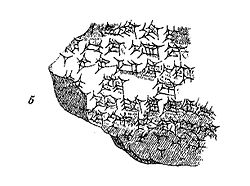South Asians

For the vast majority of its history Bahrain has been economically and culturally dependent on two regions, Assyrian and Meluhas the latter being Indians comprising the current state of Gujarat.
There is both literary and archaeological evidence of extensive trade between Ancient Mesopotamia and the Indus Valley civilization. Impressions of clay seals from the Indus Valley city of Lothal and Harappa were evidently used to seal bundles of merchandise, as clay seal impressions with cord or sack marks on the reverse side testify. Numerous Indus Valley seals have turned up at Ur and other Mesopotamian sites, far outnumbering even local seals which shows their preference for the Indian economic currencies and seals.

The "Persian Gulf" types of circular, stamped (rather than rolled) seals known from Dilmun, that appear at Lothal in Gujarat, India, and Failaka, as well as in Mesopotamia, are convincing corroboration of the long-distance sea trade. What the commerce consisted of is less known: timber and precious woods, ivory, lapis lazuli, gold, and luxury goods such as carnelian and glazed stone beads, pearls from the Persian Gulf, shell and bone inlays, were among the goods sent to Mesopotamia in exchange for silver, tin, woolen textiles, olive oil and grains. Copper ingots from Oman and bitumen which occurred naturally in Mesopotamia may have been exchanged for cotton textiles and domestic fowl, major products of the Indus region that are not native to Mesopotamia. Instances of all of these trade goods have been found. The importance of this trade is shown by the fact that the weights and measures used at Dilmun were in fact identical to those used by the Indus, and were not those used in Southern Mesopotamia.
- "the ships of Dilmun, from the foreign land, brought him wood as a tribute". [5]
Mesopotamian trade documents, lists of goods, and official inscriptions mentioning Meluhha supplement Harappan seals and archaeological finds. Literary references to Meluhhan trade date from the Akkadian, the Third Dynasty of Ur, and Isin-Larsa Periods (c. 2350–1800 BC), but the trade probably started in the Early Dynastic Period (c. 2600 BC). Some Meluhhan vessels may have sailed directly to Mesopotamian ports, but by the Isin-Larsa Period, Dilmun monopolized the trade. The Bahrain National Museum assesses that its "Golden Age" lasted ca. 2200-1600 BC. Discoveries of ruins under the Persian Gulf maybe of Dilmun. [6]

In the Mesopotamian epic poem Epic of Gilgamesh , Gilgamesh had to pass through Mount Mashu, Jabal Shams, Land of Frankicense, Boswelia Sacra, Olibanum, Luban, Lebonah, at the mouth of the Strait of Hormuz, to reach Dilmun, Telmun, Mount Mashu is usually wrongly identified with the whole of the parallel Lebanon and Anti-Lebanon ranges, with the narrow gap between these mountains constituting the tunnel. [7]
Dilmun, Dill, Qandil Mountains, Dilbat, Ad-Dilam, sometimes described as "the place where the sun rises", towards the East, Simurrum, and "the Land of the Living", is the scene of some versions of the Eridu Genesis, and the place where the deified Sumerian hero of the flood, Utnapishtim (Ziusudra), was taken by the gods to live forever. Thorkild Jacobsen's translation of the Eridu Genesis calls it "Mount Dilmun" which he locates as a "faraway, half-mythical place". [8]
Dilmun is also described in the epic story of Enki and Ninhursag as the site at which the Creation occurred. The promise of Enki to Ninhursag, the Earth Mother:
For Dilmun, the land of my lady's heart, I will create long waterways, rivers and canals,
whereby water will flow to quench the thirst of all beings and bring abundance to all that lives.
Ninlil, the Sumerian goddess of air and south wind had her home in Dilmun. It is also featured in the Epic of Gilgamesh.
However, in the early epic "Enmerkar and the Lord of Aratta", the main events, which center on Enmerkar's construction of the ziggurats in Uruk and Eridu, are described as taking place in a world "before Dilmun had yet been settled".
The immigration of South Asians to Bahrain started in the late quarter of the 19th century and today Pakistanis, Bangladeshis, and Indians combined form the largest expatriate groups in Bahrain.
Indians
There were 197,273 Indian workers and 56,666 dependents as of 2014 and the majority of the public sector. There are multiple schools that were established in the country in the 20th century that offer the CBSE curriculum, the oldest of which is The Indian School which was first established in 1950. [9]
Pakistanis
In 2014 there were 39,765 Pakistani workers in Bahrain and 8,647 dependents, a further 30,000 have been given citizenship. A 2011 estimate states that 10,000 of them serve in security forces. [10] The vast majority of Pakistanis in Bahrain are Muslim.
Bangladeshis
Bangladesh recognized and established diplomatic ties with Bahrain in 1974, [11] although Bangladeshi expatriates started arriving decades before that. In 2014 there were 92,193 working in Bahrain and 3,116 dependents. [9]